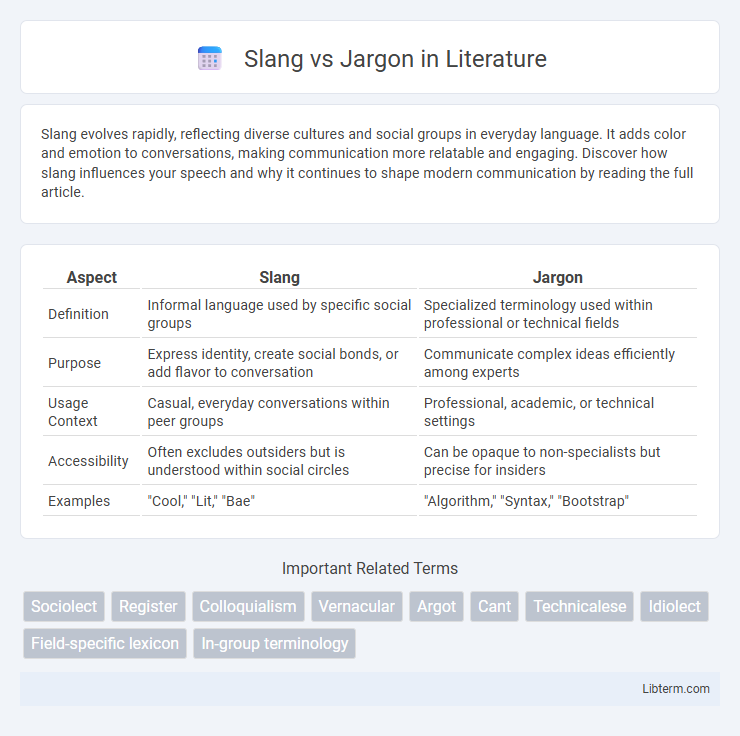Slang evolves rapidly, reflecting diverse cultures and social groups in everyday language. It adds color and emotion to conversations, making communication more relatable and engaging. Discover how slang influences your speech and why it continues to shape modern communication by reading the full article.
Table of Comparison
| Aspect | Slang | Jargon |
|---|---|---|
| Definition | Informal language used by specific social groups | Specialized terminology used within professional or technical fields |
| Purpose | Express identity, create social bonds, or add flavor to conversation | Communicate complex ideas efficiently among experts |
| Usage Context | Casual, everyday conversations within peer groups | Professional, academic, or technical settings |
| Accessibility | Often excludes outsiders but is understood within social circles | Can be opaque to non-specialists but precise for insiders |
| Examples | "Cool," "Lit," "Bae" | "Algorithm," "Syntax," "Bootstrap" |
Introduction to Slang and Jargon
Slang consists of informal, often playful language used within specific social groups, reflecting contemporary culture and evolving rapidly. Jargon comprises specialized terminology used by professionals or enthusiasts within particular fields, facilitating precise communication. Understanding the distinction between slang and jargon enhances clarity in language use across different contexts.
Defining Slang: Informal Language in Action
Slang consists of informal words and phrases used primarily within specific social groups, reflecting cultural trends and everyday speech rather than formal communication. It evolves rapidly and often lacks fixed meanings, making it dynamic and context-dependent. Unlike jargon, which serves as technical vocabulary for professional fields, slang is rooted in casual conversations and popular culture.
Understanding Jargon: Specialized Vocabulary Explained
Jargon consists of specialized vocabulary used within particular professions or groups, enabling precise and efficient communication among experts. Unlike slang, which is informal and often changes rapidly, jargon maintains consistent meanings tied to specific fields such as medicine, law, or technology. Mastering jargon enhances clarity and comprehension in professional contexts by conveying complex concepts succinctly.
Key Differences Between Slang and Jargon
Slang consists of informal, often transient expressions used primarily within particular social groups to convey casual or playful meaning, while jargon comprises specialized terminology unique to a specific profession, industry, or field, facilitating precise and efficient communication among experts. Slang tends to evolve rapidly and is generally not understood outside its social context, whereas jargon remains relatively stable and is essential for clarity and technical accuracy within its domain. Understanding the distinction helps in choosing appropriate language for either casual conversation or professional communication.
Context Matters: Where and When Slang or Jargon is Used
Slang typically emerges in informal settings among specific social groups, reflecting cultural trends and personal expression, while jargon is specialized language used within professional or technical fields to convey precise meaning. Understanding the context is essential because slang may be inappropriate or confusing in formal or professional environments where jargon clarifies complex concepts. Effective communication relies on choosing slang or jargon based on the audience's familiarity and the situational context to ensure clarity and engagement.
Slang in Popular Culture and Everyday Life
Slang in popular culture and everyday life serves as a dynamic linguistic tool that reflects social identity, trends, and group belonging, often emerging from music, sports, and online communities. It evolves rapidly, incorporating creativity and humor, making communication more colorful and expressive among peers. Unlike jargon, which is specialized terminology confined to professions or fields, slang breaks conventional language rules to create informal and relatable expressions.
Jargon in Professional and Technical Fields
Jargon in professional and technical fields consists of specialized terms and phrases unique to specific industries, facilitating precise communication among experts. This terminology often includes acronyms, technical vocabulary, and industry-specific language that enhances efficiency and reduces ambiguity in complex discussions. Mastery of jargon is essential for effective collaboration and knowledge exchange in disciplines such as medicine, engineering, law, and information technology.
The Impact of Slang and Jargon on Communication
Slang and jargon significantly influence communication by shaping how messages are interpreted within specific groups or professions, often enhancing efficiency and group identity. While slang reflects informal, culturally dynamic expressions that can create inclusion or exclusion among peers, jargon consists of specialized terminology that streamlines technical communication but may alienate outsiders. Such linguistic variations impact clarity, understanding, and social dynamics, highlighting the importance of context-aware language use in diverse communication settings.
Challenges Faced by Non-Native Speakers
Human activities significantly alter lacustrine systems through pollution, eutrophication, and water extraction, leading to habitat degradation and loss of biodiversity in freshwater lakes. Paraglacial environments are impacted by land-use changes such as agriculture, infrastructure development, and resource extraction, which accelerate sediment instability and alter natural erosion and deposition patterns. Both systems face increased vulnerability due to climate change-induced shifts in hydrology and sediment dynamics, intensifying the anthropogenic effects on their ecological balances.
Conclusion: Choosing Between Slang and Jargon
Choosing between slang and jargon depends on the target audience and the communication context. Slang suits informal settings and fosters a sense of camaraderie among peers, while jargon enhances clarity and precision within specialized fields. Effective communication requires balancing accessibility with technical accuracy to ensure the message resonates appropriately.
Slang Infographic

 libterm.com
libterm.com